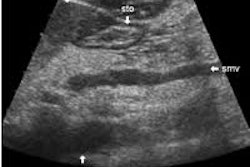(Ultrasound Review) Quantification of Doppler waveforms from uterine arteries at 20-23 weeks of gestation can predict pregnancy outcome, according to researchers at the Benjamin Franklin Clinic in Berlin. This research was published in Journal of Perinatal Medicine.
Many researchers previously have linked changes in uterine Doppler waveform to adverse pregnancy outcome, however this study analyses the degree of change and correlates that to the severity of adverse pregnancy outcome.
A routine sonographic assessment of morphology in 7,508 women was performed over a seven-year period. Doppler of both uterine arteries also was incorporated into each examination. The authors obtained five waveforms and selected the most representative. The impedance was measured using the pulsatility index (PI) and the notch index (NI) was calculated using the formula below, where D is the post-systolic nadir (low point following systole) and C is the following zenith of the waveform (highest point between systolic peaks).
Notch index = (C-D)/C
"In the majority of cases, the assessment of gestational age was estimated basing on crown-rump-length measured in the first trimester," they said. "Uterine artery waveforms were regarded as pathological in presence of a bilateral notch, or in case of bilateral high impedance with or without unilateral notch."
When an abnormal waveform was detected, 100 mg of aspirin per day was recommended. They noticed that the prevalence of notch tended to decrease with increasing gestational age. Results demonstrated a strong correlation between an increase in PI and adverse pregnancy outcome. Also, a deeper notch related to a higher rate of pregnancy complication.
The best predictor for abnormal uterine perfusion was as follows: "no notch and mean PI > P’95 or unilateral notch and mean PI > P’90 or bilateral notch and mean PI >P’50."
They found a 3.2% complication rate when the mean PI was less than or equal to 0.8 and the mean NI equaled 1.0, compared with 38.4% when the mean PI was greater than 2, with a mean NI > 0.1.
They concluded, "Doppler sonography of the uterine arteries at 20-23 weeks has the capacity to predict at least a part of severe forms of adverse pregnancy outcome and to assess the probability of complications by quantification of the impairment of the uterine blood flow."
Doppler sonography of uterine arteries at 20-23 weeks: risk assessment of adverse pregnancy outcome by quantification of impedance and notchBecker, R et al
Free University of Berlin, Klinikum Benjamin Franklin, Berlin, Germany
J Perinat Med 2002 November; 30:388-394
By Ultrasound Review
December 19, 2002
Copyright © 2002 AuntMinnie.com



















